-
 Bitcoin
Bitcoin $81,973.5211
-3.14% -
 Ethereum
Ethereum $1,771.8221
-4.70% -
 Tether USDt
Tether USDt $0.9996
-0.04% -
 XRP
XRP $2.0020
-4.93% -
 BNB
BNB $586.3762
-2.30% -
 USDC
USDC $0.9997
-0.03% -
 Solana
Solana $113.7739
-9.53% -
 Dogecoin
Dogecoin $0.1574
-7.43% -
 Cardano
Cardano $0.6244
-7.96% -
 TRON
TRON $0.2315
-2.36% -
 Toncoin
Toncoin $3.6020
-10.34% -
 UNUS SED LEO
UNUS SED LEO $9.3401
-1.03% -
 Chainlink
Chainlink $12.4356
-7.28% -
 Stellar
Stellar $0.2536
-4.73% -
 Avalanche
Avalanche $17.8372
-6.13% -
 Sui
Sui $2.2393
-7.83% -
 Shiba Inu
Shiba Inu $0.0...01195
-3.16% -
 Hedera
Hedera $0.1559
-5.48% -
 Litecoin
Litecoin $80.9170
-1.94% -
 Polkadot
Polkadot $3.8852
-4.23% -
 MANTRA
MANTRA $6.2821
-0.06% -
 Bitcoin Cash
Bitcoin Cash $298.6048
-1.78% -
 Bitget Token
Bitget Token $4.4929
-1.56% -
 Dai
Dai $0.9999
0.01% -
 Ethena USDe
Ethena USDe $0.9995
-0.03% -
 Monero
Monero $211.5827
-1.86% -
 Pi
Pi $0.5588
-16.11% -
 Hyperliquid
Hyperliquid $11.3193
-14.69% -
 Uniswap
Uniswap $5.7424
-4.67% -
 Aptos
Aptos $5.0458
-3.81%
How do blockchain browsers verify transactions?
Blockchain browsers display data verified by nodes, not verifying transactions themselves; they rely on the blockchain's consensus for accuracy and security.
Apr 01, 2025 at 03:28 pm
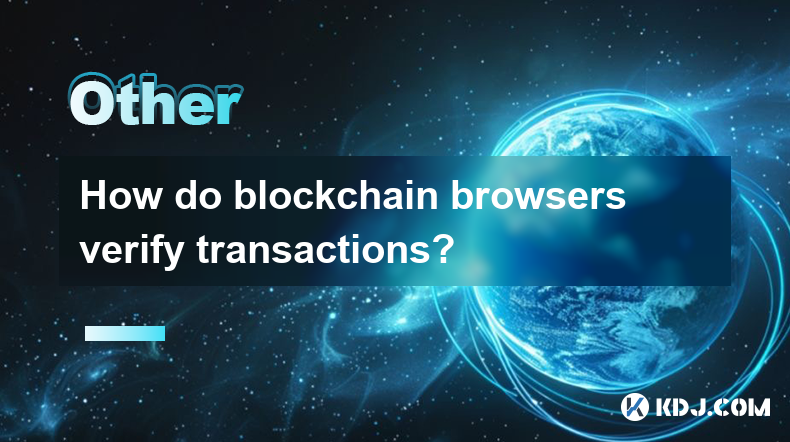
Understanding Blockchain Browser Verification
Blockchain browsers don't directly verify transactions in the same way a miner does. Instead, they act as interfaces, displaying information already verified and recorded on the blockchain. They access and interpret data from the distributed ledger, presenting it in a user-friendly format. The actual verification happens through the consensus mechanism of the specific blockchain (e.g., Proof-of-Work for Bitcoin, Proof-of-Stake for Ethereum).
The Role of Nodes in Verification
The core of blockchain verification lies in the network of nodes. Each node maintains a copy of the blockchain and independently verifies incoming transactions. These nodes use the blockchain's rules and cryptographic techniques to confirm the validity of a transaction before adding it to their copy of the blockchain. This distributed verification ensures the integrity and security of the system.
Steps Involved in Transaction Verification (From a Node's Perspective)
A blockchain browser doesn't perform these steps itself; it only displays the results. However, understanding these steps clarifies how the data a browser shows is verified.
- Transaction Broadcast: The sender broadcasts the transaction to the network.
- Transaction Reception: Nodes receive the transaction.
- Transaction Validation: Nodes verify the transaction's signature, ensuring the sender has the necessary funds and authorization.
- Block Creation: Valid transactions are grouped into blocks.
- Block Propagation: The newly created block is broadcast to the network.
- Block Verification: Nodes verify the block's validity, including the transactions within.
- Block Addition: Once verified, the block is added to the blockchain.
How Blockchain Browsers Access and Display Verified Data
Blockchain browsers connect to the network of nodes to access the blockchain data. They use APIs (Application Programming Interfaces) to retrieve information about transactions, blocks, and addresses. This data is already verified by the network of nodes before the browser accesses it. The browser then processes and presents this information in a readable format for users. This includes details like transaction IDs, timestamps, amounts, addresses involved, and block numbers.
Data Presentation and User Interaction
The browser's role is primarily visual. It doesn't independently verify anything. It simply displays the data already validated by the blockchain's consensus mechanism. Users can search for specific transactions, blocks, or addresses, and the browser will retrieve and display the corresponding verified information from the blockchain. The interface often provides tools to explore the blockchain's structure and relationships between transactions.
Security Implications
The security of the data displayed by a blockchain browser relies entirely on the security of the underlying blockchain. If the blockchain itself is compromised, the data displayed by the browser will also be inaccurate or fraudulent. Therefore, choosing a reputable blockchain browser and understanding the blockchain's security mechanisms are crucial.
Different Blockchain Browsers and their Features
Various blockchain browsers cater to different blockchains and offer varying features. Some may focus on specific blockchains like Bitcoin or Ethereum, while others might support multiple blockchains. Features can range from basic transaction viewing to advanced analytics and data visualization tools. The core functionality, however, remains consistent: displaying already verified data from the blockchain.
Exploring Transaction Details
Blockchain browsers typically allow users to explore the details of individual transactions. This might include the transaction ID, sender and receiver addresses, the amount transferred, the transaction fee, and the timestamp. This information is all part of the verified data stored on the blockchain. The browser simply provides a convenient way to access and interpret this information.
The Importance of Node Participation
The reliability of the data presented by a blockchain browser depends heavily on the number and distribution of nodes participating in the network. A network with many geographically diverse nodes is more resilient to attacks and provides a more robust verification process. The browser's accuracy is directly tied to the health and integrity of this decentralized network.
Limitations of Blockchain Browsers
While blockchain browsers offer valuable insights into blockchain activity, they have limitations. They cannot verify transactions independently; they rely on the network's verification process. Moreover, the user interface might not always be intuitive, and advanced features may require technical expertise. The amount of data displayed is limited by the browser's capacity and the blockchain's size.
Frequently Asked Questions
Q: Can a blockchain browser be manipulated to show false transaction data?
A: No, a legitimate blockchain browser cannot directly manipulate the data it displays. It retrieves data from the blockchain, which is already verified by the network of nodes. However, a malicious browser could potentially present the data in a misleading or confusing way.
Q: How does a blockchain browser handle large amounts of transaction data?
A: Blockchain browsers use efficient data structures and algorithms to handle large amounts of data. They often employ indexing and caching mechanisms to speed up data retrieval and presentation.
Q: Are all blockchain browsers the same?
A: No, different blockchain browsers offer different features, interfaces, and levels of support for various blockchains. Some may specialize in specific blockchains, while others support multiple networks.
Q: Can a blockchain browser help me recover lost cryptocurrency?
A: A blockchain browser can show you the transaction history of your address, which might help you trace the movement of your funds. However, it cannot directly recover your lost cryptocurrency. That requires other methods, depending on the nature of the loss.
Q: Is using a blockchain browser safe?
A: Using a reputable blockchain browser from a trusted source is generally safe. However, be cautious about downloading browsers from untrusted websites, as these could contain malware. Always verify the browser's authenticity and security before using it.
Disclaimer:info@kdj.com
The information provided is not trading advice. kdj.com does not assume any responsibility for any investments made based on the information provided in this article. Cryptocurrencies are highly volatile and it is highly recommended that you invest with caution after thorough research!
If you believe that the content used on this website infringes your copyright, please contact us immediately (info@kdj.com) and we will delete it promptly.
- Why XRP Investors Are Rushing to ExoraPad Presale
- 2025-04-03 21:45:12
- Polkadot (CRYPTO: DOT) cryptocurrency isn't getting any market love these days
- 2025-04-03 21:45:12
- Despite Launching the RLUSD Stablecoin, XRP Price Dips as Trump's Tariffs Trigger Market Turmoil
- 2025-04-03 21:40:11
- Ripple Has Once Again Unlocked a Massive 1 Billion XRP
- 2025-04-03 21:40:11
- Bitcoin price crashes to $80k as Trump announces tariffs on 50+ countries
- 2025-04-03 21:35:12
- Prominent crypto analyst sparks excitement with bold forecasts for Ethereum and Ripple
- 2025-04-03 21:35:12
Related knowledge
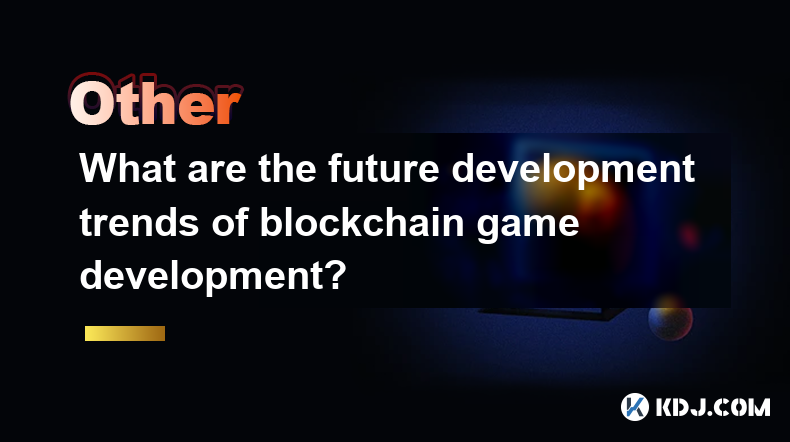
What are the future development trends of blockchain game development?
Apr 03,2025 at 05:00am
Blockchain technology has revolutionized various industries, and gaming is no exception. As we look to the future, several trends are set to shape the development of blockchain games. These trends not only promise to enhance the gaming experience but also to integrate blockchain technology more seamlessly into the gaming ecosystem. Let's explore these t...
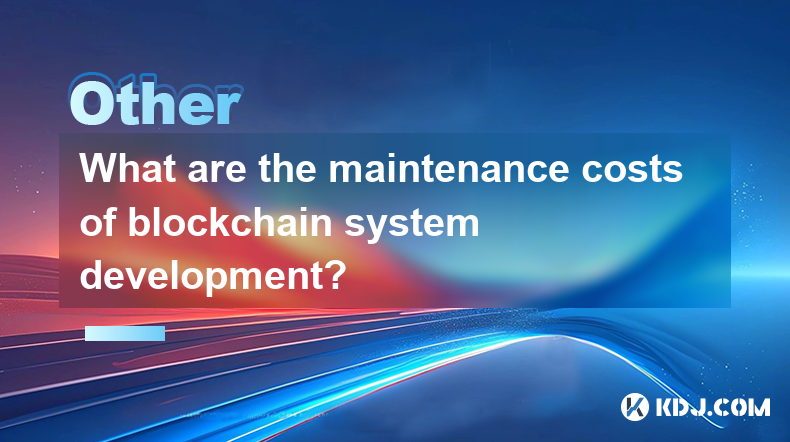
What are the maintenance costs of blockchain system development?
Apr 03,2025 at 06:07pm
The maintenance costs of blockchain system development are multifaceted and depend on various factors. These costs can include technical maintenance, security updates, infrastructure expenses, and personnel costs. Understanding these elements is crucial for anyone planning to develop or maintain a blockchain system. Technical MaintenanceTechnical mainte...
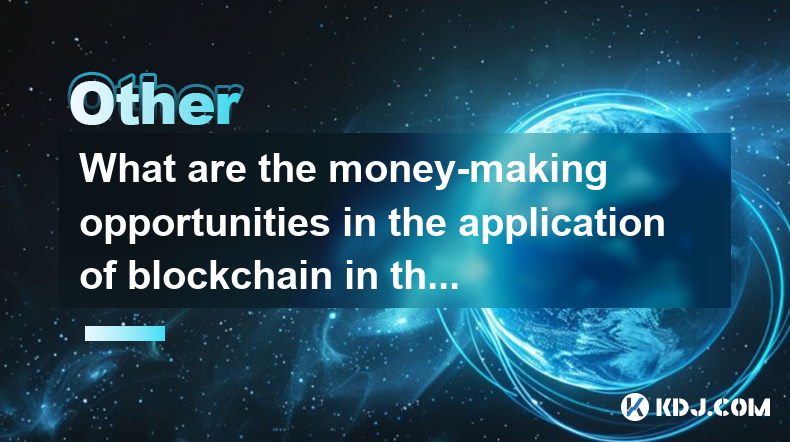
What are the money-making opportunities in the application of blockchain in the medical industry?
Apr 03,2025 at 03:35am
The integration of blockchain technology into the medical industry presents a myriad of money-making opportunities that can revolutionize healthcare systems. Blockchain's inherent characteristics, such as transparency, security, and immutability, make it an ideal solution for various medical applications. By leveraging blockchain, companies can develop ...
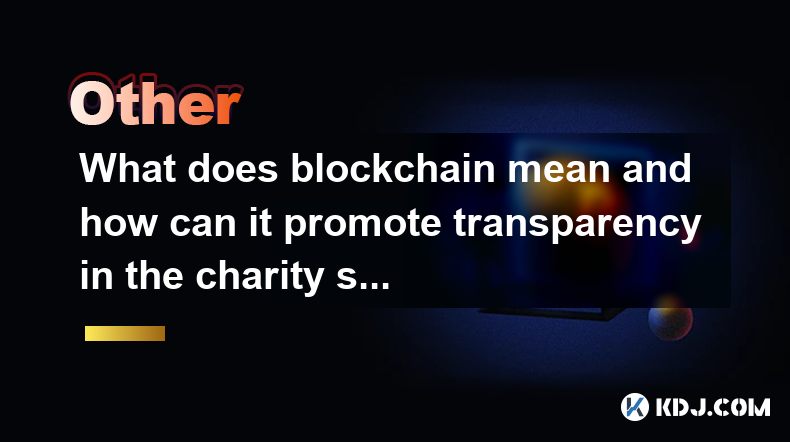
What does blockchain mean and how can it promote transparency in the charity sector?
Apr 03,2025 at 08:29pm
Blockchain technology is a decentralized, distributed ledger that records transactions across numerous computers. This ensures that the data is transparent and nearly impossible to alter retroactively. Essentially, blockchain serves as a digital ledger of all cryptocurrency transactions, enabling secure and direct exchanges without the need for intermed...
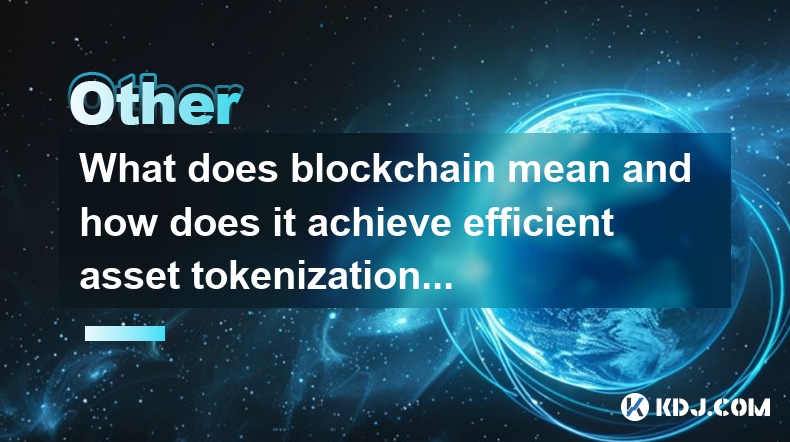
What does blockchain mean and how does it achieve efficient asset tokenization?
Apr 03,2025 at 07:57pm
Blockchain technology is a decentralized, distributed ledger that records transactions across numerous computers. It ensures that each transaction is secure, transparent, and immutable. The concept of blockchain was introduced with the launch of Bitcoin in 2009, but its applications have since expanded far beyond cryptocurrencies. At its core, blockchai...
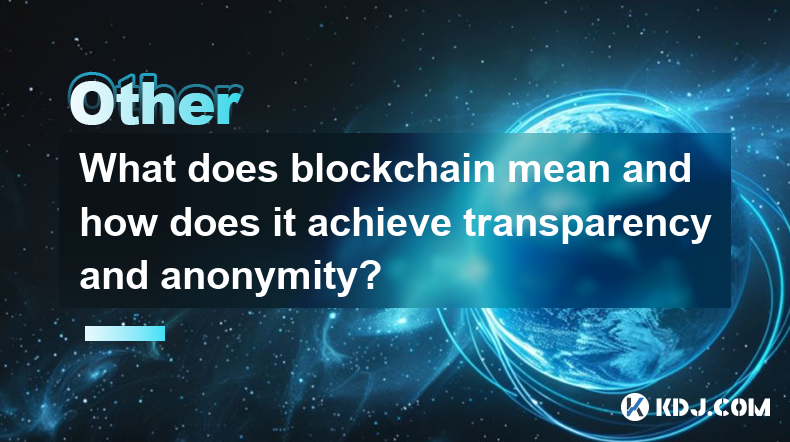
What does blockchain mean and how does it achieve transparency and anonymity?
Apr 03,2025 at 11:28am
Blockchain technology is a decentralized, distributed ledger that records transactions across numerous computers. It ensures that once data is recorded, it cannot be altered retroactively without the alteration of all subsequent blocks and the consensus of the network. This technology underpins cryptocurrencies like Bitcoin and Ethereum, providing a sec...

What are the future development trends of blockchain game development?
Apr 03,2025 at 05:00am
Blockchain technology has revolutionized various industries, and gaming is no exception. As we look to the future, several trends are set to shape the development of blockchain games. These trends not only promise to enhance the gaming experience but also to integrate blockchain technology more seamlessly into the gaming ecosystem. Let's explore these t...

What are the maintenance costs of blockchain system development?
Apr 03,2025 at 06:07pm
The maintenance costs of blockchain system development are multifaceted and depend on various factors. These costs can include technical maintenance, security updates, infrastructure expenses, and personnel costs. Understanding these elements is crucial for anyone planning to develop or maintain a blockchain system. Technical MaintenanceTechnical mainte...

What are the money-making opportunities in the application of blockchain in the medical industry?
Apr 03,2025 at 03:35am
The integration of blockchain technology into the medical industry presents a myriad of money-making opportunities that can revolutionize healthcare systems. Blockchain's inherent characteristics, such as transparency, security, and immutability, make it an ideal solution for various medical applications. By leveraging blockchain, companies can develop ...

What does blockchain mean and how can it promote transparency in the charity sector?
Apr 03,2025 at 08:29pm
Blockchain technology is a decentralized, distributed ledger that records transactions across numerous computers. This ensures that the data is transparent and nearly impossible to alter retroactively. Essentially, blockchain serves as a digital ledger of all cryptocurrency transactions, enabling secure and direct exchanges without the need for intermed...

What does blockchain mean and how does it achieve efficient asset tokenization?
Apr 03,2025 at 07:57pm
Blockchain technology is a decentralized, distributed ledger that records transactions across numerous computers. It ensures that each transaction is secure, transparent, and immutable. The concept of blockchain was introduced with the launch of Bitcoin in 2009, but its applications have since expanded far beyond cryptocurrencies. At its core, blockchai...

What does blockchain mean and how does it achieve transparency and anonymity?
Apr 03,2025 at 11:28am
Blockchain technology is a decentralized, distributed ledger that records transactions across numerous computers. It ensures that once data is recorded, it cannot be altered retroactively without the alteration of all subsequent blocks and the consensus of the network. This technology underpins cryptocurrencies like Bitcoin and Ethereum, providing a sec...
See all articles























































































